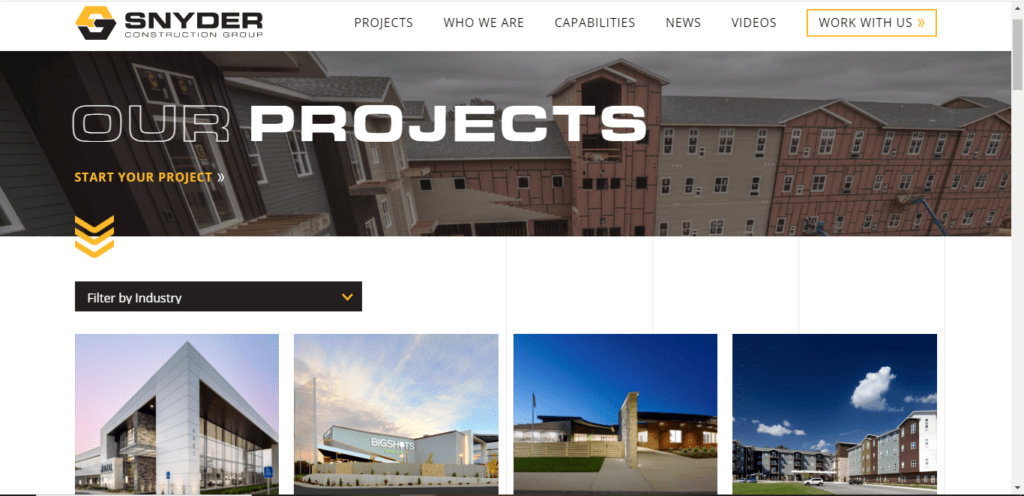Oluwadunmola Adefioye | Updated: May 17, 2023 | Home services websites

Your home builder website is the first point of interaction between your business and your customers. As such, it needs to be user-friendly and optimized for easy lead conversion. Easy as this might sound, doing this takes insight into website design and development best practices. Well, this is where website management experience and expertise come into play.
Now, as a digital marketing agency specialized in the home service business, we have helped home builders optimize their websites for better conversion. So, in this piece, I’ll share with you some of our pro tips and tricks.
Whether you’re coming in as a beginner looking to create your construction website or an established business looking to increase your conversion rates, we’ve got tips to help all.
That said, here are our suggestions you can apply to your website design and development:
Your website color scheme should convey a sense of comfort and hospitality. A good idea is to use a splash of colors, avoid excessively bright or dark hues, and make sure your chosen color grades don’t riot. A website with too much coloring can lead to a higher bounce rate of your site visitors. An easy way to go is using a color grade already on your brand logo. Your page outlook needs to be aesthetically pleasing and stimulating to drive better engagement.
As a home builder, the most effective way to market your services is by showing proof of well-done projects. This helps you establish competency with your audience and allows them to trust you more.
Your web pages should prioritize visuals over text content. One way to do this is to use pictures from your past projects as a slider or background images on your website. Make sure to avoid stock images by all means. In addition, ensure to use quality pictures only so your website won’t appear blurry.
One thing common among all the best home building websites is that they’re search engine optimized. SEO for home builder websites includes optimizing active blog posts for organic search ranking using on-page SEO. More importantly, you must ensure that technical bits for off-page SEO, like breadcrumbs and XML sitemaps, are set up on your website backend.
However, it’s important to note that what search engines really reward is good content. Be different with your blogs. Instead of writing to advertise yourself only, let your actual content be more centered around engaging and enlightening your audience on topics they’re interested in. For example, publishing a DIY video or blog post on “How to construct a gazebo in your yard” is an excellent content idea for a home builder website.
If you are ranking high as a home building website on the SERPs, you should back it up with a user-friendly website to convert the organic traffic that comes your way. If your website experience is bad for your users, then you’d probably have a high bounce rate.
Your user experience can be affected by different factors like mobile device compatibility, responsiveness, slow load time, error 404, confusing navigation, too many pop-ups, etc. Fix these problems, and you’d have a more accommodating website.
A couple of tips to ensure a pleasant experience for your users include reducing all non-essential elements like pop-up ads and applying effective navigation systems (dropdown services menu or table of contents). More importantly, you should optimize your page for mobile devices, as over 60% of all internet time comes from mobile devices.
Your business contact information should be visible as it’s vital to show your audience that you’re just a dial away. This is where your call-to-action buttons come in. You can have a CTA requesting email addresses and another for booking a free call. Make sure to use actionable phrases like “get in touch with us.”
However, don’t just spam the page with CTAs; ensure they only appear where needed, like the menu, sidebar, and promotional pop-ups. And in addition, you can also show a map with the areas where you offer your home building services.
“Pro tip: offer incentives in exchange for any action taken.”
As mentioned earlier, your projects are the strongest links in your marketing chain. Show your audience your building process and how a project went from zero to 100. This way, prospective clients can see what you have to offer in terms of expertise and service delivery.
While images are also excellent in depicting completed works, studies have shown that a majority of website visitors prefer watching service-based videos over reading text. Adding a background video to your home page is an excellent idea for this aspect. Also, don’t be monotonous; you can display varying house designs and different types of buildings.
While going against the grain might sometimes be unusual, having a web design that sets you apart and intrigues your audience is always good. And although custom designs might be costlier than regular ones, some simple changes that reflect your personal touch can work just as effectively.
Offer everyday but special features like a hovering dropdown menu, custom photo gallery, a page that scrolls up instead of down at the end, homepage slider, project portfolio, home locator extensions, etc. Making these minor adjustments to your user experience can positively impact search engine optimization and engagement metrics, including page views, time spent on the site, and conversions.
If you want to learn more about web design for home service companies, we discussed it better in our overall guide I linked here.
Dedicate a section of your website to customer testimonials from previous and current clients. This helps set you up as a company that cares about customer satisfaction above all else. And in addition, it’s easier for potential clients to relate with other customers who’ve used your service than just taking your word for it.
However, if your business doesn’t have reviews or outstanding comments yet, double down on showcasing any proof of work that you have rather than filling it with fake testimonials.
Your website should be direct and ensure your audience can get as much detail as possible about your company. Answer popular questions about the builder business, what types of houses you attend to, what building services you offer, etc. However, your answered questions shouldn’t be limited to your business alone. You should be helpful in general and explore solutions for home service problems your audience might have trouble with.
As attractive as these website design tips might sound, the average business owner won’t be able to implement them. This is where a professional comes into play. Hiring an agency with experience in the home building industry would be a terrific bargain, as they have deep knowledge and know the real-life application of website design choices.
Home builder agencies like these can bring years of website design and development expertise to ensure your business gets the best possible handling. And in addition, agencies can help with content creation and website maintenance.
Although there are many successful home builder websites from which you can draw insights, here are 3 great samples you can pattern your web design after;

Maman Corp has an amazing construction website. Besides its projects icon, the web homepage uses a background video showing the interior and exterior of an office building. They used quality images and simple colors for their website visuals. And to make navigation more interesting, each page comes with a displayed one-liner copy and an accompanying text.

Snyder Construction Group easily ranks as one of the best home building websites because of their attention to detail. The website has a standard background video display alongside icons that direct users to their preferred destinations. Their projects catalogs are replete with stunning pictures showing the completed works and a youtube video documenting the building process. However, my favorite feature was how the projects were arranged and could be searched by industry.

The Jova Construction business website is another example of excellent designs in the construction industry you can emulate. Even though the page does not use a background video, its styling and special features make up for it.
What I loved about the website is how the pinned header displays the menu even while scrolling. And while viewing their projects, the project pictures fuse to create a gliding effect that I found appealing.
Google Analytics and Google Search Console are top tools you can associate on your website to monitor user engagement. While each product slightly differs, they both perform the primary function of tracking user data to inform your website update decisions.
Website personalization involves using the user’s experience to make website changes that’ll better serve the user, while in website customization, the user manually makes these changes. For instance, selecting your artist preferences on a music player is customization, while personalization is the player recommending similar songs or artists based on your previous data.
Some significant metrics you can track to monitor your website performance include bounce rate, average time on page, conversion rate, and unique visitors. Tracking these metrics will help you gain a deeper knowledge of user engagement as you gain insight into key conversion events and triggers.
While running your design, remember that simplicity is best; you don’t want to clutter up your page with loud designs that might overwhelm the user and increase your bounce rate. Ensure basics like company contact and CTAs are present, exhibit your projects to show competency, and optimize your page for SERPs and mobile compatibility.
As stated earlier, these guidelines are great for home builders but can also be applied to all home service businesses.
No matter how formidable your website is, a home builder marketing campaign is still the best strategy for driving conversions, customer engagement, and overall sales. Klutch Growth specializes in all digital marketing strategies for home service contractors, from web design to PPC advertisements like Google Ads. Kindly click on the dropdown icon labeled services to get extra insight into our offered solutions.

I enjoy writing engaging and practical articles that help local businesses grow. That’s why I take my time to understand the industry - customers and businesses - before writing a word.
Aside from content marketing, I enjoy watching football and love my beloved Arsenal FC.
Hire Klutch Growth